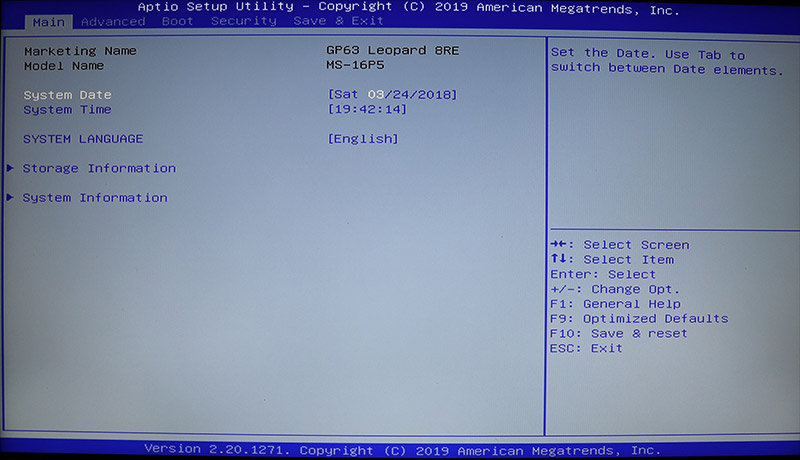

- AMI BIOS CONFIGURATION PROGRAM UPDATE
- AMI BIOS CONFIGURATION PROGRAM ANDROID
- AMI BIOS CONFIGURATION PROGRAM SOFTWARE
- AMI BIOS CONFIGURATION PROGRAM WINDOWS
When you press F2 to enter BIOS Setup, the system interrupts the Power-On Self-Test (POST). Just press the F2 key when the following prompt appears: Press to enter Setup. USING KEYS The following table lists the BIOS Setup keys and their functions: KeyĮNTERING BIOS SETUP You can access the BIOS program just after you turn on your computer. Settings displayed in blue are automatically detected by your computer. Options that are greyed out are not available for the current selection. This area lists alternate settings and Help text for each parameter. Available Options and Help - the right side of the screen.This area lists parameters and their current settings. Parameters - the left side of the screen.This area highlights which menu is active. System Parameters and Standard Settings LOOKING AT SCREENS BIOS setup screens have three areas: customise your hardware settings according to your needs,.The BIOS settings also identify installed devices and establish special features.
AMI BIOS CONFIGURATION PROGRAM SOFTWARE
The BIOS (Basic Input/Output System) is a layer of software, called ‘firmware’, that translates instructions from software (such as the operating system) into instructions that the computer hardware can understand. INTRODUCING BIOS SETUP Your computer comes with a hardware configuration program called BIOS Setup that allows you to view and set system parameters. 22 AMIBIOS® is a registered trademark of American Megatrends Inc.

Introducing BIOS Setup.2 Main Menu.4 Advanced Menu.10 Power Manager Menu.17 Security Menu.18 Boot Menu.

Setting items to incorrect values may cause your system to malfunction.ĪMIBIOS Setup Utility, version MS1421 & MS164x, 06/2007 Modifications to the BIOS Setup settings should be performed by advanced users only.
AMI BIOS CONFIGURATION PROGRAM UPDATE
With Intel’s Alder Lake switching to a radical new hybrid core chip design this fall, and both Intel and AMD expected to roll out new motherboard sockets next generation, we may soon be an era where it’s more common to update your BIOS while bleeding-edge kinks get worked out.AMIBIOS® Setup Utility System Parameters and Standard Settings Several motherboard BIOS updates were released early during the first generation of AMD’s disruptive Ryzen chips, and each provided additional performance and system stability. That said, you probably want to stay on top of BIOS updates if you’re on a chip or motherboard platform that’s fresh out of the gates. It’s best not to update your UEFI firmware unless there is something specific that the updated firmware offers that you need.
AMI BIOS CONFIGURATION PROGRAM ANDROID
At one time, this was considered a risky practice, given that the firmware updating process can potentially brick your motherboard in the same way that flashing a custom ROM on to Android phone can brick the device. Some people like to regularly check for and update their UEFI firmware packages just to stay up to date. For years, the only real reason to update to a newer firmware revision, however, is to solve a bug in your UEFI or to swap in a CPU that’s newer than your motherboard. Over the lifespan of a motherboard, manufacturers release new firmware packages or BIOS updates that will enable support for new processors and memory, or solve commonly reported bugs. Your motherboard likely uses whatever firmware revision the motherboard manufacturer was on back when it was built. New chip and motherboard platforms often receive numerous BIOS revisions early in their lifecycle, to work out bugs. Understanding your UEFI is important so you can understand how (and if) to take advantage of the feature updates and bug fixes that come with the BIOS updates offered by motherboard manufacturers. Why you should (or shouldn’t) update your BIOS That said, most people still call the UEFI the “BIOS” because of the familiarity of the term.
AMI BIOS CONFIGURATION PROGRAM WINDOWS
But a few years ago, motherboard manufacturers-in partnership with Microsoft and Intel-introduced a replacement for traditional BIOS chips dubbed UEFI ( Unified Extensible Firmware Interface).Īlmost every motherboard shipping today has a UEFI chip rather than a BIOS chip (UEFI is a Windows 11 system requirement, in fact), but they both share the same core purpose: preparing the system to boot into the operating system. It not only powers your PC, but helps protect it, too-as Duo Security’s recent report on Apple macOS attacks points out.īIOS stands for basic input and output system, and the BIOS chip initializes all the other devices in your PC, like the CPU, GPU, and motherboard chipset. A tiny BIOS chip lurks inside every computer, sitting on your motherboard to breathe life into your system when you press the power button.


 0 kommentar(er)
0 kommentar(er)
